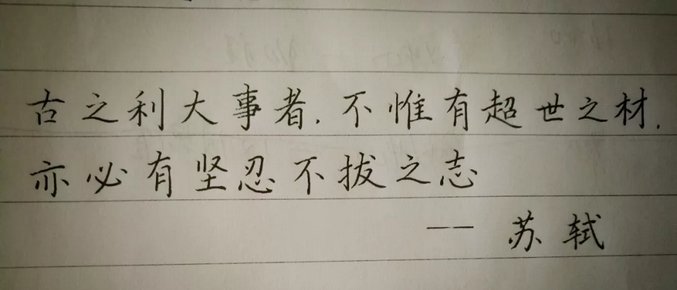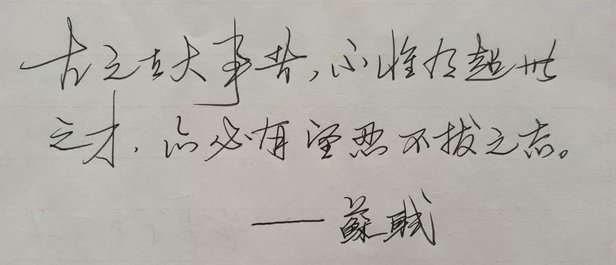Many friends who want to practice calligraphy ask: How do I practice calligraphy? The answer I got was nothing more than: copy. Then he asked again, how long will it take to practice? Is it true that 21 days of quick calligraphy training is possible? Is there a faster way?
This is a troublesome but unavoidable question. I don’t know how to answer it, and there is no standard answer. However, it is impossible to quickly practice calligraphy in 21 days, because calligraphy training is measured in months and in years. We understand everyone's desire for "quick success", but only a lot of practice time can bring out your essence, so we are opposed to promoting calligraphy as a quick fix. In fact, not only practicing calligraphy, but also many things in life require effort.

Let me summarize some of the questions that friends often ask, and give you a more comprehensive answer based on all types of questions. Not much to say, let’s get straight to the point!
1. How can I practice calligraphy well?
If you want to learn a new skill and do it well, all you need to do is: start, find the right direction and method, and stick to it.
These three points seem very simple, but they are not easy to achieve. The problems we usually encounter are: we don’t know how to start, we can’t find a good method, and we can’t persevere. If you solve these three problems well, it will not be difficult to write well.
2. How to start practicing calligraphy?
Before we start, we need to think about a question first. Why do we practice calligraphy? Or what is my pursuit of practicing calligraphy?
There are two types of calligraphy we practice. One is calligraphy. Only writing that meets the requirements of calligraphy is called calligraphy. The other is relatively free writing that does not pursue standards and regulations. We can call it handwriting or Jianghu style. If you have higher requirements for yourself and want to practice calligraphy, you must copy the copybooks. Ancient calligraphy is best, but you can also start with less difficult modern calligraphy. In short, I started by copying copybooks. Handwriting also has its own beauty. Some babies think that I don’t pursue such high standards, and I just want to practice my usual calligraphy to be more beautiful. Then I still have to copy, and imitation is learning. Therefore, whether it is calligraphy or handwriting, it all starts with copying.
3. What is copying? How to copy?
Copying is actually divided into two parts, one is "copying" and the other is "copying". To copy means to write or draw according to the original work, and put the original work aside to copy; to copy means to write or draw on the original work with thin paper (silk). Obviously, for beginners, they should copy first and then practice. Those who get started quickly can focus on copying and copy as a supplement. The ancients said: "When copying a calligraphy, it is easy to lose the position of the ancients, but to gain more of the ancients' writing style; when copying the calligraphy, it is easy to gain the position of the ancients, but to lose more of the ancients' writing style." The process of copying is from physical resemblance to spiritual resemblance, from imitation (drawing red) to imitation (Opposite). Of course, beginners can also try copying and practicing by interweaving copying and copying, which may lead to unexpected gains.
4. How to choose copybooks?
If your foundation is poor, or your ambitions are not that high, you can practice from modern copybooks. Here is a small advertisement for Mo Dianjia. Teacher Jing Xiaopeng’s copybooks are standardized, beautiful and easy to use. You are worth a dozen. If you really want to pursue calligraphy or have a certain foundation, then you should copy more ancient calligraphy. When copying ancient calligraphy in writing, you can start with the relatively easy-to-use "Ling Fei Jing" or Wen Zhengming's "Qin Fu" and "Ten Records of the Thatched Cottage". If the foundation is relatively poor, you can combine copying, that is, combining red tracing and copying. It is not recommended to draw red all the time. This way it is difficult to find problems during the writing process.
5. What kind of font is suitable for me?
Everyone's personality, aesthetics, etc. are different, so it depends on personal preference. If your personality is more reserved and gentle, it is good to practice regular script and official script, or it may be more suitable to practice these. If you are a wild horse, unrestrained and love freedom, then running script or even cursive script is actually more suitable for you. It also depends on individual circumstances. If your calligraphy is already good, or your handwriting is already pretty, then if you want to write more elegantly, you can also practice running script directly. Of course, if you feel that the handwriting you write is no different from the handwriting you wrote in elementary school, then it is best to practice regular script first, because regular script allows you to clearly understand the frame structure of a character, which is useful for later learning running script and running script. Very helpful. In short, it is still recommended that beginners start with regular script and not rush for success.

6. Is it true that 21 days of quick calligraphy training is possible? Can calligraphy be practiced quickly?
Responsible to say, no.
For example: Is instant chicken delicious? Unappetizing. Is ripened watermelon delicious? Unappetizing.
Furthermore, we cannot be too utilitarian in practicing calligraphy, and we cannot practice calligraphy just for some secular purposes. If we develop calligraphy practice as a hobby, we will feel that it is a very lucky thing.
People who really like to practice calligraphy will never be satisfied with the current status of their calligraphy. Creation and practice require persistence.
We are already impetuous enough in this era. If you like practicing calligraphy, don’t let practicing calligraphy become a thing that makes you anxious.
7. How to choose pen and paper?
It is recommended to use a fountain pen or a water pen (gel pen) to practice calligraphy.
If you want to practice calligraphy, it is recommended to use Japanese or domestic pens. Western pens have harder tips and are not easy to draw sharp edges. It is recommended to choose a pen with an M tip. It is recommended to choose 0.7 or 1.0 gel pen. Easier to grasp changes in thickness.
Each kind of pen can be bought to write with, and see which one is the best weapon for you.
As for the paper, there are no special requirements. The recommended order of practice is to start with the rice grid, followed by the field grid, then the graph paper, and finally the linear draft. For students who are just starting to practice calligraphy, it is recommended to practice with mizige. Later, as your level improves, you can gradually use square grids, horizontal grids, vertical grids, etc.
So what we talk about when practicing calligraphy is stability and persistence, rather than some 21-day quick fix. There is a 10,000-hour time rule that says that if you do something to the extreme, you will be a master, so when you practice calligraphy, you Practice it to the extreme and you will be a master.








